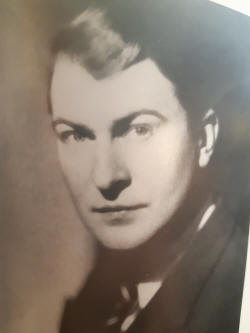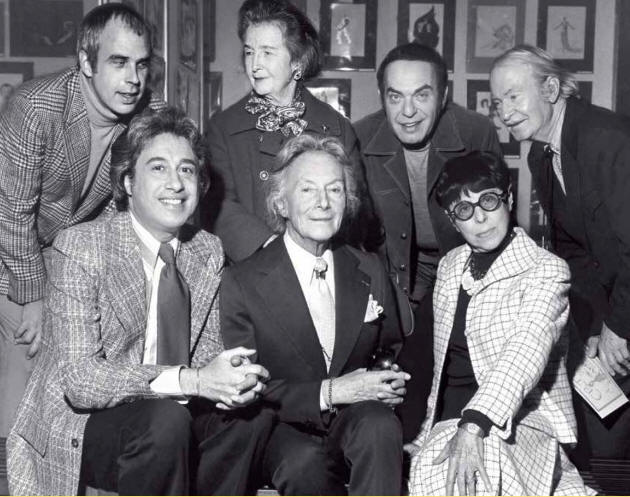

Partner Sascha Brastoff
Queer Places:
Shoup Ave, Woodland Hills, CA 91367
2522 Military Ave, Los Angeles, CA 90064
 Howard Shoup (August 29, 1903 – May 29, 1987) was an American costume
designer who received 5 Academy Award nominations (for The Young Philadelphians, The Rise and Fall of Legs Diamond, Claudelle Inglish, Kisses for My President
and A Rage to Live).[6]. Shoup was the long-term
romantic partner of artist Sascha Brastoff.[1]
They lived quite openly for some 40 years. Their names were linked in press
accounts; they often arrived together for social functions, sometimes with
female dates, sometimes not.
Howard Shoup (August 29, 1903 – May 29, 1987) was an American costume
designer who received 5 Academy Award nominations (for The Young Philadelphians, The Rise and Fall of Legs Diamond, Claudelle Inglish, Kisses for My President
and A Rage to Live).[6]. Shoup was the long-term
romantic partner of artist Sascha Brastoff.[1]
They lived quite openly for some 40 years. Their names were linked in press
accounts; they often arrived together for social functions, sometimes with
female dates, sometimes not.
Born in Dallas, Texas, on August 29, 1903, Howard was a feminine little boy, an attribute that unnerved his father, Francis, an engineer for the telephone company. In 1910, Howard was sent to Sewanee, Tennessee, to spend a summer with his grandaunt, the novelist Sarah Barnwell Elliott. Thanks to Aunt Sada, Shoup's family appears to have come around, and Howard remained close and affectionate with them all his life.
He began college at the University of Washington in St. Louis but soon transferred to the Pratt Institute in New York to study design. In 1924 he got a job at Hattie Carnegie; in 1929 he moved over to the noted fashion house Bonwit-Teller. Hollywood agent Minna Wallis met him at a party and encouraged him to give movies a try. Hired by Warner Bros., Shoup's presence was resented by Orry-Kelly; consequently, Howard worked mostly on lower-budget pictures.
When costume designer Howard Shoup went to bid farewell to cast and crew of DuBarry Was a Lady, it was the height of WWII and he was being shipped off to basic training. Arriving on the lost resplendent in his air force uniform, his pants were sharply creased and his gold buttons gleaming. But when Lucille Ball took one look at him, she burst out laughing. "Now," she managed to say, "I've seen everything." "Howard was a screamer," said one man who knew him well. "You know how some guys are just so obvious? That was Howard. Open his mouth and a purse fell out." Slight and delicate, Shoup had never made any pretense about being gay. Following in the tradition fo Walter Plunkett and Orry-Kelly, , he was blithely unconcerned with image, and so fully appreciated the laughter of Ball and the crew. He well understood the irony.

Back Row (L to R), Bill Hargate, Sheila O'Brien, Michael Woulfe, and
Howard Shoup, Front Row (L to R) Burton Muller, Erte, Edith Head.
Howard Shoup met Sascha Brastoff while in drag. Commissioned by Moss Hart to do the costumes for his war-themed Broadway morale booster, "Winged Victory," Shoup created for Brastoff an outrageous Carmen Miranda costime, done up in a mix of cartridge belts and bananas. Hart called it "the greatest sight gag in show business." At some point during the production, Shoup and Brastoff fell in love. Brastoff became, in the words of Shoup's nephew, "Howard's truest and closest family." "Winged Victory" showcased the tradition within armed forces to entertain the troops with all-male productions. It was later reprised in the subsequent film (directed by George Cukor), preserving for all generations Brastoff's campy Carmen Miranda.
Shoup would come into his own after moving to MGM in the 1940s, and then returned to Warner Bros. in the early 1950s, creating the costumes for Calamity Jane (very butch cowhide for Doris Day), The Helen Morgan Story, Marjorie Morningstar, and The Young Philadelphians, among many others.
After the war, Brastoff would continue his act on the Los Angeles social scene, turning up in 1953 in the pages of Harper's Bazaar dolled up in bananas and hootcheekootchee costume, designed by Shoup, of course. "I don't like zis boy," Miranda reportedly said. "He looks more like me zan me."
Shoup had over 170 film credits during his long career. Including films like Cabin in the sky (1943), The Jazz Singer (1952), Calamity Jane and So Big (both 1953), Pete Kelly's Blues and The Court-martial of Billy Mitchell (both 1955), The Helen Morgan Story (1957), A Summer Place (1959), Ocean's 11 (1960), Rome Adventure and Gypsy (both 1962), Hotel (1967) and his last picture, Cool Hand Luke (1967).
In 1953, nine Hollywood film Costume Designers gathered to form a guild "to advance the economic, professional and cultural interests of its members." They were Marjorie Best, Renie Conley, Elois Jenssen, Sheila O'Brien, Leah Rhodes, Howard Shoup, William Travilla, and Michael Woulfe. Shoup was the president and served four terms. They were soon joined by other talented Costume Designers of Hollywood's Golden Era, including Edith Head and Walter Plunkett.
Shoup and Brastoff bought a home together on Military Avenue, and Brastoff ran a ceramic business, designing lamps, china, and jewelry. They shared their lives until Howard's death in 1987. Although Brastoff wasn't mentioned in Shoup's obituary, by the time of Brastoff's death in 1993, Shoup was retrospectively acknowledged, so markedly had the times changed.
My published books:>